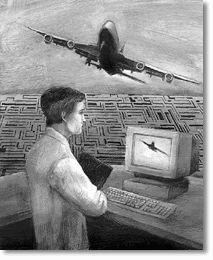 "Human-factors research involves finding the mismatches between
people and systems and looking for ways to correct them," said Colin
Drury, UB professor of industrial engineering and principal
investigator.
"Human-factors research involves finding the mismatches between
people and systems and looking for ways to correct them," said Colin
Drury, UB professor of industrial engineering and principal
investigator. 
The Proactive Error Reduction System (PERS) program, funded by the Federal Aviation Administration's Office of Aviation Medicine, is based on a human-factors approach to solving errors.
 "Human-factors research involves finding the mismatches between
people and systems and looking for ways to correct them," said Colin
Drury, UB professor of industrial engineering and principal
investigator.
"Human-factors research involves finding the mismatches between
people and systems and looking for ways to correct them," said Colin
Drury, UB professor of industrial engineering and principal
investigator.
The UB researchers are applying "best practices" systems from quality programs in manufacturing environments to airline inspections.
For several years, Drury and his co-workers have analyzed errors by airline workers in detail. They are using this knowledge to build practical tools that allow users to advance quickly to solutions to errors made by airline workers.
"The idea behind our work is that you should not just determine the immediate cause of the error, but examine all the things that led up to it," Drury explained.
"PERS not only tells you what to do if an error occurs, but it also tells you what to do even if what has occurred are not errors, but error-prone situations," he said.
One area under study involves damage incurred by planes while they are on the ground.
"While such accidents may not affect passenger safety, an airline may spend tens of millions of dollars per year on ground damage," said Drury.
PERS provides a way for airline personnel to analyze an error or a potential error, to discover why it occurred and then to see how they might go about changing systems, equipment or work patterns to prevent future errors.
According to Drury, the analysis goes beyond the simple fact that, for example, an aircraft was hit by a ground vehicle driven by a mechanic.
The program asks: Why was the mechanic there? What was the mechanic doing? Why was he in a hurry?
"In one instance, we found that drivers of ground vehicles often put the vehicles into neutral, but did not turn them off when they got out of the vehicles for the simple reason that the engines got so cold they would be difficult to restart," said Drury.
By providing such detailed information about an incident, the airline should be able to pinpoint and address the chain of events that led up to the error.
The FAA-funded project began in 1989 following Congressional hearings prompted by an incident in which 18 feet of roof pulled away from an Aloha Airlines jet as it was flying over the Pacific Ocean. A flight attendant was sucked from the plane and 61 passengers were injured.
ILLUSTRATION BY HEATHER KABAZA